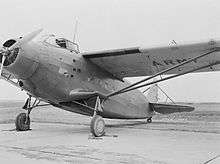Kreider-Reisner XC-31
| XC-31 | |
|---|---|
| | |
| Role | Single-engine transport |
| National origin | United States |
| Manufacturer | Fairchild Aircraft |
| First flight | September 22, 1934 |
| Primary user | United States Army Air Corps |
| Number built | 1 |
|
| |
The Kreider-Reisner XC-31 or Fairchild XC-31 was an American single-engined monoplane transport aircraft of the 1930s designed and built by Kreider-Reisner. It was the largest single-engine aircraft built to that time,[1] as well as one of the last fabric-covered aircraft tested by the U.S. Army Air Corps.[2] Designed as an alternative to the emerging twin-engined transports of the time such as the Douglas DC-2, it was evaluated by the Air Corps at Wright Field, Ohio, under the test designation XC-941,[2] but rejected in favor of all-metal twin-engined designs.
The XC-31 was built with an aluminum alloy framework covered by fabric, and featured strut-braced wing and a fully retractable landing gear, the main gear units mounted on small wing-like stubs and retracting inwards. An additional novel feature was the provision of main cargo doors that were parallel with the ground to facilitate loading.

Following evaluation by the USAAC, the XC-31 was transferred to NACA, which used it for icing studies at its Langley Research Center.[3]
Specifications
General characteristics
- Crew: 1 (Pilot)
- Capacity: 15 passengers or 3,500 pounds (1,600 kg) of cargo
- Length: 55 ft 5 in (16.89 m)
- Wingspan: 75 ft in (22.86 m)
- Height: 15 ft 10 in (4.83 m)
- Wing area: 802 ft2 (74.5 m2)
- Empty weight: 7322 lb (3321 kg)
- Gross weight: 12750 lb (5783 kg)
- Powerplant: 1 × Wright R-1820--25 radial, 750 hp (559 kW)
Performance
- Maximum speed: 154 mph (248 km/h)
- Cruise speed: 143 mph (230 km/h)
- Range: 775 miles (1247 km)
- Service ceiling: 15,000 ft (4570 m)
See also
- Aircraft of comparable role, configuration and era
- Related lists
References
| Wikimedia Commons has media related to Kreider-Reisner XC-31. |
- ↑ Pattillo, Donald M. (1998). Pushing the Envelope: The American Aircraft Industry. University of Michigan: University of Michigan Press. pp. 79–80. ISBN 978-0472086719. Retrieved 2 April 2010.
- 1 2 3 "Kreider-Reisner XC-31 Fact Sheet". Online Aircraft Features. National Museum of the US Air Force. Retrieved 2 April 2010.
- 1 2 "Fairchild Model XC-31 Cargo Transport". History of Airplanes. acepilots.com. Retrieved 2 April 2010.